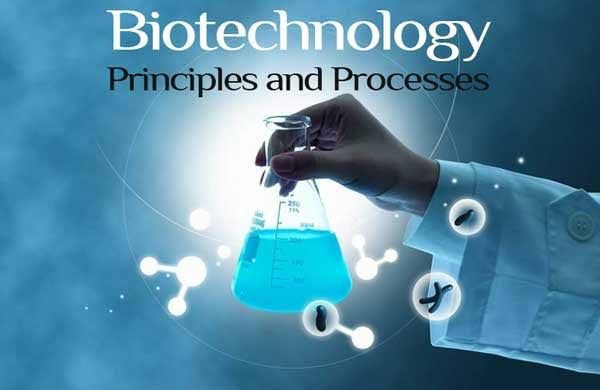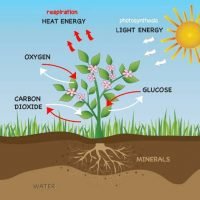Biotechnology Principles and Processes MCQ for NEET exam Preperation with Explained Answer keys from NCERT and Previous Year asked questions. Most important questions.
These Biotechnology Principles and Processes MCQ NEET questions are taken from NCERT and Previous year papers.

Answer Keys for this Biotechnology Principles and Processes MCQ NEET questions is also given at the end of this page.
ALL THE BEST
Biotechnology Principles And Processes MCQ NEET Important Questions
1) The linking of antibiotic resistance gene with the plasmid vector became possible with?
a) DNA polymerase
b) Exonucleases
c) DNA ligase
d) Endonucleases
2) A gene whose expression helps to identify transformed cell is known as?
a) Selectable marker
b) Vector
c) Plasmid
d) Structural gene
3) Human insulin is being commercially produced from a transgenic species of?
a) Rhizobium
b) Saccharomyces
c) Escherichia
d) Mycobacterium
4) PCR and Restriction Fragment Length Polymorphism are the methods for?
a) Study of enzymes
b) Genetic transformation
c) DNA sequencing
d) DNA Fingerprinting
5) Choose the correct option for the toxic protein produced by B.thuringiensis?
a) It acts in acidic medium and binds to epithelial cells of foregut
b) It acts in neutral medium and binds to epithelial cells of hindgut
c) It acts in alkaline medium and binds to epithelial cells of foregut
d) It acts in alkaline medium and binds to epithelial cells of midgut
6) In recombinant DNA technique the term vector refers to?
a) Plasmids that can transfer foreign DNA into a living host cell
b) Cosmids that can cut DNA at specific base sequence
c) Plasmids that can join different DNA fragments
d) Cosmids that can degrade harmful proteins
7) An analysis of chromosomal DNA using the southern hybridization technique does not use?
a) Autoradiography
b) PCR
c) Electrophoresis
d) Blotting
8) The enzymes which are absolutely necessary for recombinant DNA technology are?
a) Restriction endonucleases and topoisomerases
b) Endonucleases and polymerases
c) Restriction endonucleases and ligases d) Peptidases and ligases
9) In genetic engineering, the antibiotic resistance used as?
a) As selectable markers
b) To select healthy vectors
c) As sequences from where replication starts
d) To keep the cultures free of infection
10) A genetically engineered micro-organism used successfully in bioremedication of oil spills is a species of?
a) Pseudomonas
b) Trichoderma
c) Xanthomonas
d) Bacillus
11) Identify the plasmid?
a) Bam HI
b) Hind III
c) Eco RI
d) pBR322
12) Crown gall disease in plants is caused by?
a) Ti-plasmid
b) Ri Plasmid
c) pBR Plasmid
d) Virus
13) Which of these is used as vector in gene therapy for SCID?
a) Arbovirus
b) Rotavirus
c) Enterovirus
d) None of these
14) Which of the following organelles is related with genetic engineering/gene cloning?
a) Golgi apparatus
b) Lysosomes
c) Mitochondria
d) Plasmids
15) A desirable change in genotype of an organism is obtained by?
a) DNA replication
b) Protein synthesis
c) rDNA technology
d) m-RNA formation
16) The role of DNA ligase in the construction of a recombinant DNA molecule is?
a) Formation of phosphodiester bond between two DNA fragments
b) Formation of hydrogen bonds between sticky ends of DNA fragments
c) Ligation of all purine and pyrimidine bases
d) None of the above
17) Which of the following is not a source of restriction endonuclease?
a) Haemphilus influenzae
b) Escherichia coli
c) Entamoeba coli
d) Bacillus amyloliquefaciens
18) Which of the following steps are catalysed by Taq DNA polymerase in a PCR reaction?
a) Denaturation of template DNA
b) Annealing of primers to template DNA
c) Extension of primer end on the template DNA
d) All of the above
19) A bacterial cell was transformed with a recombinant DNA molecule that was generated using a human gene. However, the transformed cells did not produce the desired protein. Reasons could be?
a) Human gene may have intron which bacteria cannot process
b) Amino acid codons for humans and bacteria are different
c) Human protein is formed but degraded by bacteria
d) All of the above
20) Which of the following should be chosen for best yield if one were to produce a recombinant protein in large amounts?
a) Laboratory flask of largest capacity
b) A stirred-tank bioreactor without in-lets and out- lets
c) A continuous culture system
d) Any of the above
21) Who among the following was awarded the Nobel Prize for the development of PCR technique?
a) Herber Boyer
b) Hargovind Khurana
c) Kary Mullis
d) Arthur Kornberg
22) The stirred-tank reactor is usually?
a) Cylindrical
b) Rounded
c) Cup-shaped
d) Flattened
23) A bioreactor refers to?
a) A device in which substances are treated to stimulate biochemical transformation by living cells
b) A nuclear reactor for biological studies
c) A tank for biochemical reactions
d) Organisms badly reacting to stimuli
24) Why is recombinant DNA (rDNA) technology called genetic engineering?
a) It involves sophisticated technology at
microscopic level
b) Knowledge of engineering is must in rDNA technology
c) It involves manipulation of two DNAs
d) It includes an authorized degree in engineering
25) In rDNA technology, in order to make the bacterial host cells ‘competent’ to accept the rDNA, these are kept in?
a) Dilute solution of CsCl
b) Divalent anions such as phosphates
c) Chilled ethanol
d) Divalent cations such as calcium
26) PCR needs?
a) Primers
b) Taq polymerase
c) Nucleotide as raw materials
d) All of these
27) Restriction endonucleases hydrolyzes polynucleotide from?
a) Only the 5′ end
b) From either terminal
c) At an internal phosphodiester bond
d) A phosphodiester bond within a specific sequence
28) Antibiotic resistance gene present on BamHI site of a E. coli cloning vector is?
a) Ampicillin resistance
b) Tetracycline resistance
c) Chloramphenicol resistance
d) Kanamycin resistance
29) Selection of recombinants due to inactivation of antibiotics is a cumbersome procedure because?
a) It requires plating of one plate having certain antibiotics
b) It requires plating of two plates having same antibiotics
c) It requires simultaneous plating on two plates having different antibiotics
d) None of these
30) In E. coli cloning vector pBR322. ROP codes for?
a) The proteins involved in the replication of the plasmid
b) The protein involved in the antibiotic resistance
c) The proteins involved in the synthesis of antibiotic
d) All of these
31) The bacteria associated with plant genetic engineering are?
a) Salmonella and Pseudomonas
b) Salmonella typhimurium and Agrobacterium
c) Bacillus thuringiensis and Pseudomonas fluorescens
d) Both b and c
32) If recombinant DNA is inserted within the coding sequence of enzyme galactosidase. Which of the following will occur in case of non-recombinants?
a) Insertional activation
b) Colonies do not produce any colour
c) Chromogenic substrate gives blue colour
d) Inactivation of enzyme galactosidase
33) In case of pBR322, which of the following act as selectable markers?
a) ampR
b) ori site
c) tetR
d) Both a and c
34) Agarose extracted from sea weeds finds use in?
a) Gel eletrophoresis
b) Spectrophotometry
c) Tissue culture
d) PCR
35) Continuous addition of sugars in ‘fed batch’ fermentation is done to?
a) Degrade sewage
b) Produce methane
c) Obtain antibiotics
d) Purify enzymes
36) Biolistics (gene-gun) is suitable for?
a) Disarming pathogen vectors
b) Transformation of plant cells
c) Constructing recombinant DNA by joining with vectors
d) DNA finger printing
37) In genetic engineering, the antibiotics are used?
a) As selectable markers
b) To select healthy vectors
c) As sequences from where replication starts
d) To keep the culture free of infection

Biotechnology Principles And Processes MCQ NEET Important Questions – Answer Keys
1) C. DNA ligase is genetic or DNA adhesive – a specific type of enzyme, a ligase, (EC 6.5.1.1) that facilitates the joining of DNA strands together by catalyzing the formation of a phosphodiester bond.
2) A. A selectable marker is a gene introduced into a cell, especially a bacterium or to cells in culture, that confers a trait suitable for artificial selection.
3) C. Recombinant human insulin has been produced predominantly using E. coli for therapeutic use in human.
4) D. DNA fingerprinting is a method used to identify an individual from a sample of DNA by looking at unique patterns in their DNA. restriction fragment length polymorphism, or RFLP, is a technique
that exploits variations in homologous DNA sequences. It refers to a difference between samples of homologous DNA molecules from differing locations of restriction enzyme sites
5) D. It acts in alkaline medium and binds to epithelial cells of midgut
6) A. Plasmids that can transfer foreign DNA into a living cell
7) B.
8) C. Restriction endonucleases : Chemical knife and ligases: Genetic gum
9) A. Genes that confer resistance to various antibiotics are used as selective markers in cloning vectors. Normally the genes encoding resistance to antibiotics such as ampicillin, chloroamphenicol, tetracycline or kanamycin, etc., are considered useful selectable markers for E. coli.
10) A. The crude oil degradation –> Pseudomonas putida.
11) D. Bam HI, Eco RI & Hind III are restriction endonuclease; pBR322 is plasmid of E.coli
12) A. Ti (tumor-inducing) plasmid based vectors are high efficiency vectors and were developed with the aim of introducing genes into plants.Agrobacterium tumefaciens causes crown gall disease
in plants in which cells grow in anundifferentiated and uncontrolled manner to form a tumor.
13) D. Retroviruses used as Vector
14) D. Plasmid used as vectors
15) C. rDNA technology is genetic engineering
16) A. Formation of phosphodiester bond between two DNA fragments
17) C. Entamoeba coli is a protozoa
18) C. Extension of primer end on the template DNA
19) A. Human gene may have intron which bacteria cannot process
20) C. A continuous culture system
21) C. Kary Mullis
22) A. Cylindrical
23) A. A device in which substances are treated to stimulate biochemical transformation by living cells
24) C. It involves manipulation of two DNAs
25) D. The cell is treated with a specific concentration of a divalent cation such as calcium to increase pore size in cell wall.
26) D. All of these required for PCR
27) D. A phosphodiester bond within a specific sequence
28) B. Tetracycline resistance
29) C. It requires simultaneous plating on two plates having different antibiotics
30) A. The proteins involved in the replication of the plasmid
31) D. Both b and c
32) C. Chromogenic substrate gives blue colour ; The rDNA or recombinant DNA is inserted within the coding sequence of the enzyme galactosidase. This results in inactivation of the enzyme. In the presence of chromogenic substrate, blue coloured colonies are produced if the plasmid in the
bacteria doesn’t have the insert i.e. those are non recombinant.
33) D. Both a and c
34) A. Gel eletrophoresis
35) D. Purify enzymes
36) B. Transformation of plant cells
37) A. As selectable markers
More Post Related to Biotechnology Principles And Processes MCQ NEET Important Questions
Must visit these page for more study materials.






 155 out of 200 questions were directly asked from these notes in NEET 2024
155 out of 200 questions were directly asked from these notes in NEET 2024
